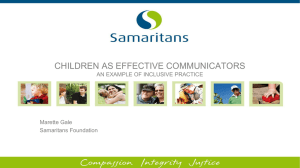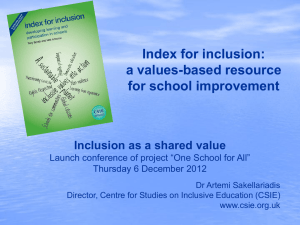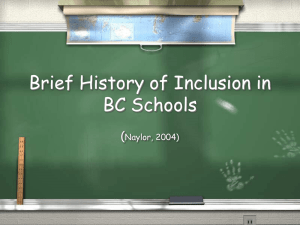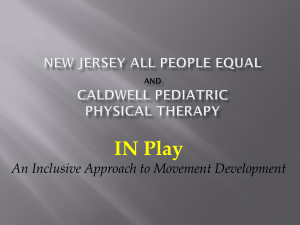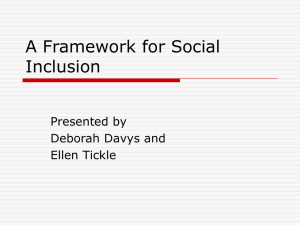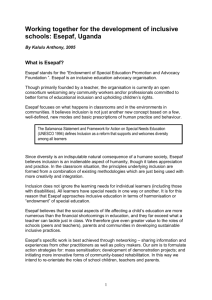Promoting Successful Inclusion
advertisement
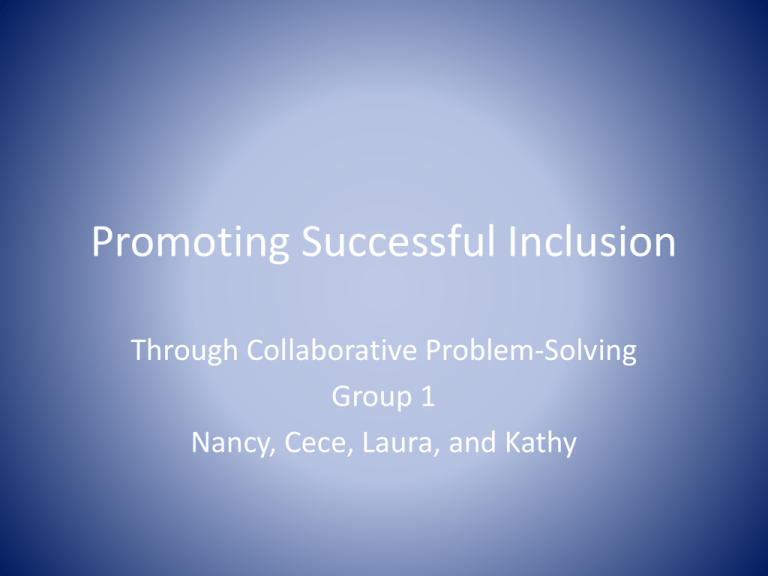
Promoting Successful Inclusion Through Collaborative Problem-Solving Group 1 Nancy, Cece, Laura, and Kathy Learning Objectives • Identify factors that promote collaboration in inclusive classrooms. • Determine how collaboration problem solving or CPS would enhance collaboration in the inclusive classroom. Successful Inclusion • Hobbs & Westling, (1998). Inclusion, Inclusion, Promoting Successful Inclusion Through Collaborative ProblemSolving. The Council for Exceptional Children, 12-18. • Inclusion is a process, not an event. Problem solutions evolve over time rather than occur randomly. • Percentage of LD students in self contained settings has decreased since the 1990s and there is more inclusion. • Success depends on the teacher’s preparation and attitudes and that there is an opportunity for collaboration. • Needs adequate planning time and parent, community support, adapted curriculum, cooperative learning, and teacher collaboration. Continued • Collaborative Problem Solving or CPS is a way to identify problems or barriers related to inclusion. • Address problems together • Collaboration has to be voluntary, have parity, presumes mutually agreed on goals, requires shared responsibility and resources where the team must be collectively responsible for the outcomes. • CPS provides a systematic process for identifying which strategies or tactics might be useful. • Top ten ways teachers collaborate. Top Ten Ways Teachers Collaborate • http://whatedsaid.wordpress.com/2011/05/18/10-ways-forteachers-to-collaborate/ • Open Door • Talk • Be Open Minded • Include Your Students • Make Learning Trans-disciplinary • Share • Focus on the Arts • Establish an online communication forum • Create an online communication forum • Create a global collaboration (skype, etc..) Tool • Use the worksheet to identify five ways teachers collaborate in inclusive settings that are not already listed. • Work in pairs. Dover (2005) • Essential that special and general educators collaborate in order to provide instruction to students. • Tips for collaboration in an inclusive classroom • 1. Keep schedules of teacher’s planning times • 2. Review student work together • 3. Help each other prioritize instructional objectives. • 4. Conduct interviews to complete paperwork • 5. Offer direct assistance in the classroom. • 6. Meet with others to review key student information. • 7. Listen to the experiences needs and concerns of others. • The author stressed that teacher collaboration is one of the most important factors in having successful inclusion. Carter, Prater, Jackson & Marchant (2009) • Effective collaboration between special education and general education teachers increases the likelihood that students will be included successfully in general ed. classrooms • “CRIME” is one tool to train pairs of special educators and general educators to work through the collaborative process to benefit students in inclusion settings. • “CRIME” was developed to help pairs of staff to effectively collaborate together (Curriculum, Rules, Instructions, Materials, Environment) • Time to collaborate continued to be the number one barrier to collaboration. • Differences in defining disability was the number one issue to collaborating effectively. References • Carter, N., Prater, M., Jackson, A., & Marchant, M. (2009). Educators’ Perceptions of Collaborative Planning Processes for Students with Disabilities. Preventing School Failure, 54(1), 60-70. • Dover, W. F. (2005). Consult and support students with special needs in inclusive classrooms. Intervention in School and Clinic, 40(1), 32-35. • Hobbs, T., & Westling, D. L. (1998). Inclusion Inclusion Promoting Successful Inclusion Through Collaborative Problem-Solving, The Council for Exceptional Children, 12-18.



